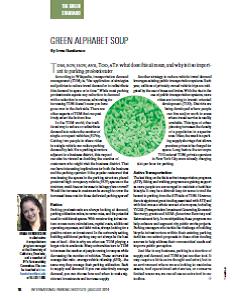TDM, SOV, HOV, AVR, TOD, ATP. What does this all mean, and why is it so important to parking professionals?
According to Wikipedia, transportation demand management (TDM) is, “the application of strategies and policies to reduce travel demand or to redistribute this demand in space or in time.” While most parking professionals equate any reduction in demand with a reduction in revenue, advocating for increasing TDM doesn’t mean you have gone over to the dark side. There are other aspects of TDM that can positively affect the bottom line.
In the TDM world, the traditional way to reduce or redistribute demand is to reduce the number of single-occupant vehicles (SOVs). Getting two people to share rides in a single vehicle can reduce parking demand by half. For a parking structure adjacent to a business district, this carpool can also be viewed as doubling the number of customers who might visit the business district. That can have interesting implications for both the business and the parking operator: If the popular restaurant that was leasing the spaces in the parking structure placed preferred high-occupancy vehicle (HOV) spaces on the first floor, could it see an increase in its happy hour crowd? Would the increase in customers be enough to cover the increased lease cost for those dedicated parking spaces?
Ratios
Parking professionals are always looking at demand, parking utilization ratios, turnover rates, and the potential need for additional spaces. With constructing infrastructure comes more calculations, capital costs, additional operating expenses, and debt ratios, always looking for a positive return on investment. In the university setting, building additional parking may not always be the best use of land—this is why we often see TDM playing a larger role in academia. Many universities turn to TDM to increase the number of people coming to campus while decreasing the number of vehicles. These universities manage that ratio—average vehicle ridership (AVR)—the same way they manage their parking utilization. Back to supply and demand: If you can effectively manage demand, you can choose how and when to make significant investments and increase supply.
Another strategy to reduce vehicle travel demand leverages existing public transportation systems. Each year, millions of privately owned vehicle trips are mitigated by the use of buses and trains. With the rise in the use of public transportation systems, more cities are turning to transit-oriented development (TOD). Districts are being developed where people can live and/or work in areas where transit service is readily available. This type of urban planning increases the density of a population in a specific area. Often, the result is a parking supply shortage that allows premium prices to be charged for space. Long before the acronym TOD entered TDM, private operators in New York City were already charging $30 per hour for parking.
Active Transportation
The last thing on the list is active transportation programs (ATP). Biking and walking programs are gaining support as more people are encouraged to maintain a healthier lifestyle. It may be a difficult leap for some to find the benefit to parking from the ATP side of TDM. However, there is significant grant funding associated with ATP, and with that comes a whole new set of acronyms, including TIGER (Transportation Investment Generating Economic Recovery) grants and ARRA (American Recovery and Reinvestment Act). In municipalities, these programs can help enhance and augment city public works projects. Parking managers who tackle the challenge of building bicycle infrastructure within their existing parking facilities can submit proposals to these other funding sources to help address their communities’ needs and improve public perception.
Just like in any business, parking is a function of supply and demand, and TDM is just another tool. It may require a little extra thought and effort, but in an environment where we are looking to maximize assets, find operational efficiencies, or conserve limited resources, we can all use an extra tool in our toolbox.
Irma Henderson is alternative transportations program manager at the University of California, Riverside, and a member of IPI’s Sustainability Committee. She can be reached at irma.henderson@ucr.edu or 951.827.1060.
TPP-2014-08-Green Alphabet Soup

